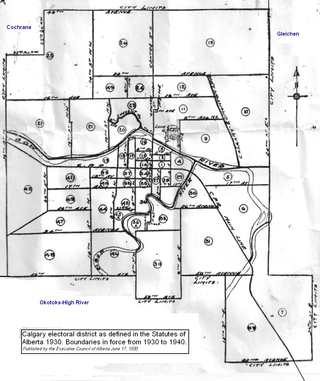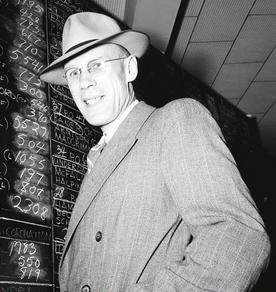Results
- bold or
 indicates elected
indicates elected - italics indicate incumbent
- "SS", where data is available, indicates representative for Edmonton's South Side, with a minimum South Side representation instituted after the city of Strathcona, south of the North Saskatchewan River, amalgamated into Edmonton on February 1, 1912.
Mayor
| Party | Candidate | Votes | % | Elected | |
|---|---|---|---|---|---|
| Independent | Kenneth Alexander Blatchford | 8,314 | 65.28% | ||
| Independent | James Ramsey | 4,421 | 34.72% | ||
Aldermen
Six seats open. 11,851 valid votes.
Quota of votes was 1693. This number guaranteed election but it was possible to be elected with fewer. [2]
Two southside candidates had to be elected. [3]
| Party | Candidate | Initial Votes | Elected | ||
|---|---|---|---|---|---|
| Labour | James East | 3,004 | |||
| Independent | Ambrose Bury | 1,993 | |||
| Independent | William Rea | 1,150 | |||
| Independent | James McCrie Douglas | 928 | SS | ||
| Independent | Thomas Ducey | 789 | |||
| Labour | James Findlay | 707 | |||
| Independent | Archie Rendall | 703 | |||
| Independent | Joseph Duggan | 563 | SS | ||
| Independent | J. J. McKenzie | 420 | SS | ||
| Independent | Esther Saunders* | 380 | |||
| Independent | J. Boyd McBride | 317 | |||
| Independent | A. K. Putland | 312 | SS | ||
| Labour | H. J. Pallot | 308 | |||
| Labour | Jan Lakeman | 265 | SS | ||
14 candidates ran for the six seats open this year.
10 counts were required to see all the seats filled under the STV/PR system in use.
As votes were transferred in the nine counts that followed the first count, the candidates' relative popularity changed. Ducey and Rendall received many initial votes but did not get quota and did not get enough votes in later counts to get a seat.
Rea was third in the first count but did not receive many vote transfers and eventually was declared elected to serve one-year term, the consolation prize. He was the least popular (last elected) of the northside candidates.
As seen in the above vote tallies, the front runners in the first count were mixed, belonging to both Independent (business) and Labour slates. This was the result of single voting in a multi-member district.
East and Bury were elected on first count, receiving quota. Their surplus votes were transferred to prevent waste and to ensure rough proportionality of the election result.
The second count was the distribution of East's surplus votes. Findlay received enough vote transfers from East to achieve quota on the 2nd count.
The 3rd Count was transfer of Bury's surplus votes. The 4th count was transfer of Findlay's surplus votes.
Then the least-popular candidates were eliminated one by one until the next seat was filled. Lakeman, Pallot, Putnam, McBride, Saunders and McKenzie were eliminated before that happened.
Rea achieved quota on the 10th count to take a seat. His surplus votes were not transferred because the field of candidates was such that the remaining seat would be immediately filled.
Rea's election left only two seats empty (and four candidates still standing).
Northsiders Thomas Ducey and Rendall, and two southside candidates were left standing by this point.
No southsiders had been elected so the two remaining seats had to be filled by southsiders.
Rendall and Ducey were eliminated, there being no northside seats left to win.
The two southside candidates (Douglas and Duggan) were allocated seats to fill the two vacancies for guaranteed southside representation, as was announced the next day. [4]
There was no business slate per se.
On the other hand, the Labour element of the city had put forward Labour Party candidates. But the STV election did not involve parties. Voters cast votes directly for individual candidates.
East and Findlay were newly elected Labour candidates. Rice Sheppard and Dan Knott were sitting labour councillors and had one more year in their terms so Labour, with four seats, had good representation in the 1924 city council. Through the next several city elections, held using STV, Labour maintained its grip on the four seats, a very dependable result produced by a dependable scientific method. [5]
Other than the change produced by the southside quota, all the candidates in winning positions in the first count were elected by the end after transfers, but single voting in multi-winner contest assured that each party received its due share of seats.
Public school trustees
Four seats needed to be filled in this election. Each voter cast one vote as per STV.
| Party | Candidate | Initial Votes | Elected | ||
|---|---|---|---|---|---|
| Labour | Samuel Barnes | 3,239 | |||
| Independent | F. S. McPherson | 1,769 | |||
| Labour | Frank Crang | 1,740 | SS | ||
| Independent | Ralph Bellamy | 1,643 | |||
| Independent | George Steer | 1,054 | |||
| Labour | Robert McCreath | 1,015 | |||
| Independent | George Massey | 442 | |||
The necessary quota to win a seat was 2183 (the total of votes divided by five, plus one).
Barnes achieved this in first count to get a seat.
Enough of his surplus went to Frank Crang who thus got a seat in the second count.
Bellamy and McPherson were elected in the fifth count, held after Massey and Steer had been eliminated, their second choices being distributed.
McCreath, who had picked up many votes in the second and third counts (thus moving up from the bottom of the pack where candidates were being eliminated), was dropped off in the fifth count, leaving only two candidates left to fill the two remaining slots, thus Bellamy and McPherson were elected. [6]
The four candidates in winning positions wre elected in the end after transfers, but the single voting in multi-winner contest ensured that both parties were represented among them.
Separate (Catholic) school trustees
Robert Crossland (SS), Paul Jenvrin, Thomas Magee, and Joseph Henri Picard were acclaimed.






